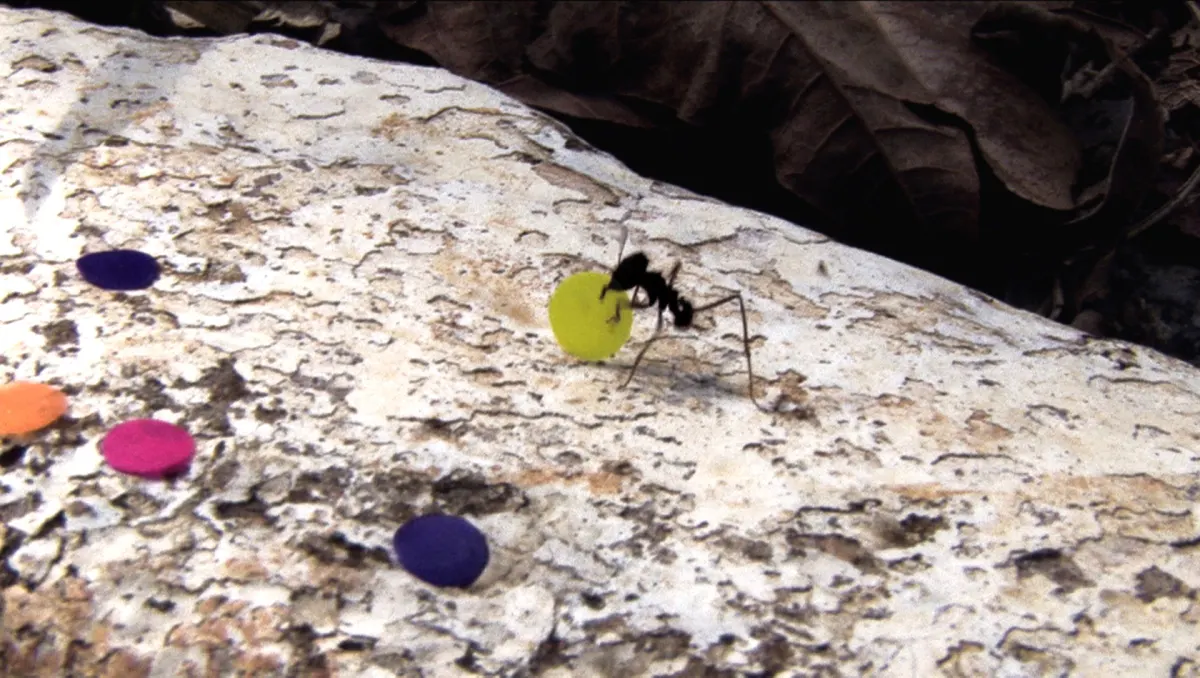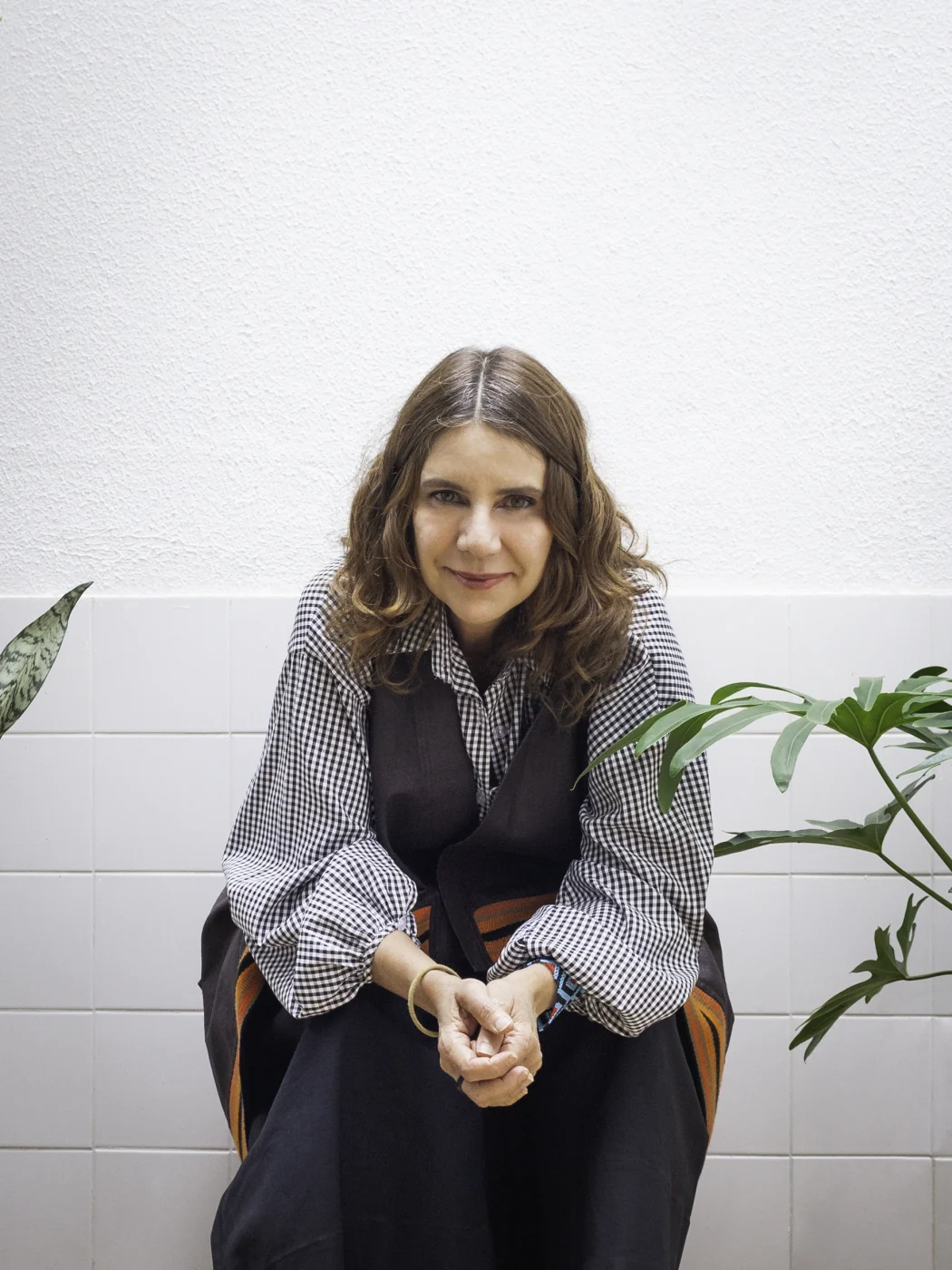'Quarta-Feira de Cinzas / Epilogue' 2006 is currently on display in Room 1 of 'Start Display' in the Natalie Bell Building on Level 2 as part of the permanent collection at Tate Modern, London, UK.
The work is a single channel video lasting 5 minutes and 48 seconds and shown on a loop. It features a ground-level, close-up view of red and black ants carrying coloured confetti across the floor of the Brazilian rainforest. The film starts with one ant carrying a piece of gold confetti over a gritty surface, followed by shots of differently sized ants attempting to grip or drag confetti across soil and tree trunks. As the video progresses it begins to show multiple ants per scene: a pair collaborate to move a disc up a small hill, and a group fights over a piece of silver confetti. The vegetation surrounding the insects becomes denser and the shots show increasing numbers of ants and confetti pieces, the brightly coloured, often reflective discs contrasting with the earthy tones of the rainforest. The video concludes with a multitude of ants carrying their confetti into a dark crevice in the soil.
The film's soundtrack combines ambient noises, such as bird calls, leaves rustling and cars passing, with the rhythmic sound of matchsticks hitting the ground. The latter are intermittent at first, becoming more constant during the film's second half. The work is displayed in a 5 x 7 or 6 x 8 metre room with black walls and a dark grey carpet, and projected onto the wall at a width of 3-4 metres. The projection area is covered with reflective white paint and positioned at a height that corresponds roughly to the eye level of the seated viewer (see ‘Specifications for the Room', instructions from Galeria Fortes Vilaça to Tate, 4 April 2007, Tate Conservation File).
This work was created by Brazilian artists Rivane Neuenschwander and Cao Guimarães. It was filmed on 1 March 2006 in the Brazilian state of Minas Gerais. This date marks Ash Wednesday, the first day of the annual Christian season of Lent, a forty-day period of fasting and repentance that precedes Easter. To make the film, the artists saturated the confetti discs in pork fat and sugar, thus making them attractive to the ants, and recorded images and sounds as the ants interacted with the confetti. The soundtrack was composed digitally by O Grivo, a Brazilian experimental band, by mixing the sounds recorded during filming with elements of samba music played with matchsticks, specifically the early 1950s song ‘Me Deixa em Paz' by Monsueto and Airton Amorim.
In the work's title, the Brazilian Portuguese ‘Quarta-Feira de Cinzas' translates to Ash Wednesday. As well as marking the start of Lent, this is the last day of the Carnaval festival, an important four-day celebration in Brazil. ‘Epilogue' may therefore refer to the fact that Ash Wednesday represents the aftermath of Carnaval festivities. Neuenschwander has described the work as an attempt to ‘capture the mood of the end of the festival, when there is a certain melancholy after the days of madness and excess' (Neuenschwander in Luke 2009, p.97). This melancholy may relate to the self-deprivation that follows Carnaval as Lent begins, and to the prospect of returning to the normal rhythms of work and life - a process alluded to in the ants' efficient transportation of the confetti.
As Neuenschwander has explained, samba and confetti-throwing have strong associations with Carnaval in Brazil (Luke 2009, p.97), while the matchbox, alluded to through the sound of matchsticks, is widely used in Brazil as an improvised rhythm instrument for samba. Confetti is a recurring element in Neuenschwander's works, such as Estórias Secundárias (Secondary Stories) 2006, a room-sized installation in which large circles of brightly coloured tissue paper are blown around by fans set above a transparent ceiling structure. They resemble oversized confetti, echoing the amplified scale of the confetti in Quarta-Feira de Cinzas / Epilogue. Both works were first displayed as part of Neuenschwander's Other Stories and Stories of Others exhibition at Tanya Bonakdar Gallery, New York, in September-October 2006.
Neuenschwander and Guimarães have worked together since the late 1990s on a number of short films. Curator Heather Pesanti has argued that the collective nature of the ant colony in Quarta-Feira de Cinzas / Epilogue can be seen as a metaphor for Neuenschwander's collaborative approach to her work more generally. The use of ants also allows parallels to be drawn between animal behaviour and the social rituals of human communities, exploring the boundaries between natural and constructed worlds. For instance, curator and art historian Denise Carvalho has interpreted the laborious ant procession with the confetti loot as an allegory for the cleaning of cities after Carnaval is celebrated, a job often performed by the working classes.
Neuenschwander and Guimarães were influenced by the Brazilian neo-concrete movement of the 1950s and 1960s, which was formed as a response to the 1950s concrete art movement. The neo-concretists rejected concrete art's pursuit of pure form and aimed to incorporate subjectivity and sensory experiences into their work, to better ‘express the complexities of modern human realities' (Ferreira Gullar, ‘Manifesto Neoconcreto', Jornal do Brasil: Suplemento Dominical, 21-2 March 1959, pp.47-8). In this sense, these two artists' practices can be placed between the documentary and the poetic, exploring natural and cultural phenomena through works that concentrate on what Guimarães calls ‘micro-dramas of form' - apparently ordinary elements and events that hold dramatic potential (Guimarães in Felipe Scovino, Arquivo Contemporâneo, Rio de Janeiro 2009, p.49). Neuenschwander uses the term ‘ethereal materialism' to describe her poetic interpretation of everyday events and materials, and of their ephemerality and unpredictability. She has often used living creatures in her practice, stating of her work with ants that ‘What fascinates me ... is the collaboration between chance and control' (Neuenschwander in Luke 2009, p.97).

